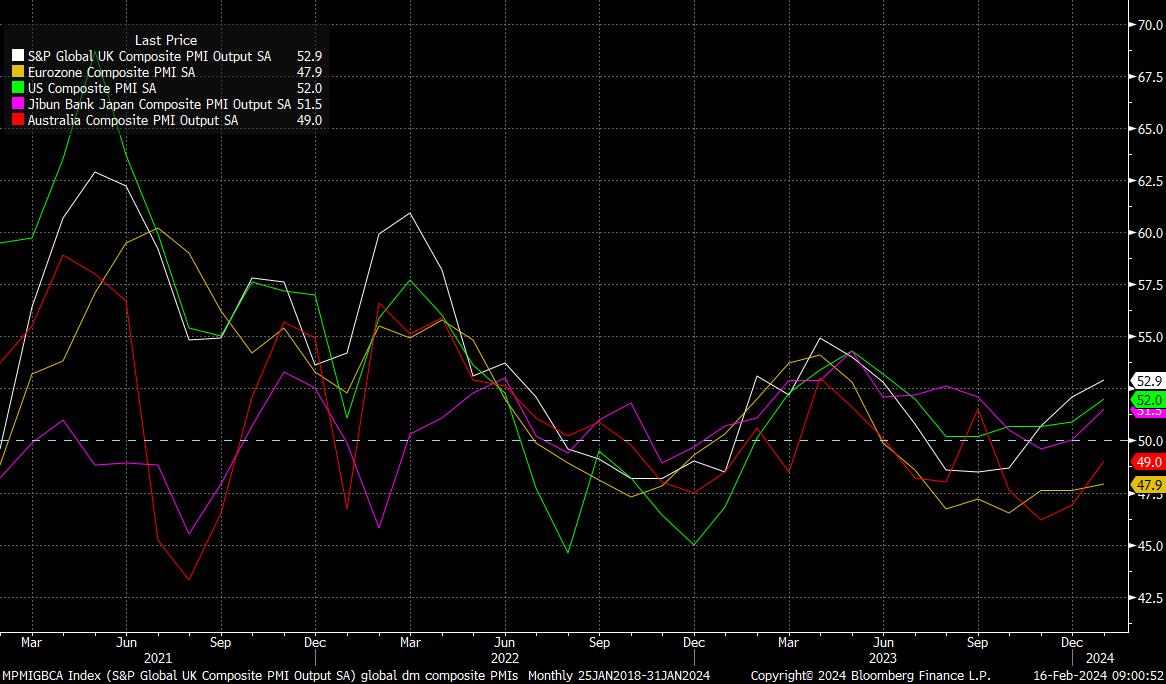On the Spot: Trading in a Political World

February 19, 2024
Market run-through
Another week ended with the markets facing more questions than answers. The UK appears to have good employment and retail sales whilst in a recession, with wages growing almost uncomfortably fast. When taken as a whole, the economic picture looks increasingly like one of stagflation. It also doesn’t look like Prime Minister Sunak will get the improving economic conditions he was hoping for and will probably be forced to push the election back as far as it can go, possibly until December. However, with the back benches restless and Nigel Farage fanning the flames of discontent, questions are being asked whether he can hang on that long. Currency markets don’t like uncertainty and historically are suspicious of Labour administrations, which leaves sterling increasingly vulnerable.
The US also has a mixed picture with disappointing retail sales released last week whilst employment looks strong with signs that inflation is starting to reappear. The timing of the first rate cut by the Fed is being pushed further back, giving renewed strength to the good old greenback. The US has its own election in November this year, which looks increasingly bitter reflecting a deeply divided country. The closer we get to an election, the harder it is for the Fed to cut as it, of course, wants to avoid any allegation of bowing to political influence. The week ahead is pretty quiet data-wise, with only existing home sales, S&Ps indexes and leading economic indicators on the agenda. In common with our US cousins, the UK and Europe have S&P’s indicators published, which tend to be unreliable. What is never unreliable is the market’s interest in the minutes from central bank meetings, and Wednesday’s release of the last FOMC minutes will be studied avidly for policy hints, as will the wise words from the plethora of Fed speakers this week.
Richard Matthews, Head of FX and Payment Partnerships

Behind the desk
Whilst there has been a lot of speculation surrounding Bitcoin’s price in the lead-up to the next Bitcoin halving, there’s a wider debate on whether the economic incentives underlying Bitcoin’s security will continue to be sufficient.
Bitcoin’s security budget, funded by block subsidies and transaction fees, is crucial for maintaining network integrity and resilience against potential attacks. The hash rate which measures the total amount of mining occurring on the network, indicates the security of Bitcoin’s blockchain at a given point in time. As block subsidies fall, Miners are less incentivised to continue to provide security.
Bitcoin’s innovative difficulty adjustment algorithm dynamically adjusts how difficult it is to mine a block based on the number of network participants and directly follows the trend in the hash rate of the network. When the total hash rate declines, the difficulty of mining declines as well. The reduction in mining rewards may result in a consolidation within the mining sector with smaller Miners struggling to remain profitable, and larger players with greater resources, cheaper sources of energy and economies of scale dominating the industry with increased returns as their relative share of the total hash rate increases.
One avenue Miners are exploring to remain profitable is reducing the cost of mining, and finding more sustainable energy sources. The industry is now experimenting with different mining methods, including using flare gas from oil wells, solar power to provide sustainable, clean energy, and geothermal power for cheap and continuous power supply.
As block rewards decrease over time, transaction fees will increasingly become the main source of income and incentive for miners. A report by Grayscale found more than $200 million in transaction fees related to the development of the BRC-20 standard and Ordinals has been paid out to miners so far, and miners currently make about 20% of their revenue from transactions related to ordinals.
Whilst sceptics remain concerned as to whether fees will maintain sufficient levels of security, the price and purchasing power of Bitcoin should adjust to the lack of new supply and the scarcity of Bitcoin. Although the past isn’t always a clear indicator for the future, between all three previous halvings, the Bitcoin price denominated in U.S. Dollars has increased at least 900%, more than enough to compensate miners for the 50% drop in Bitcoin-denominated revenue.
Pritpal Shokar, Senior Product Manager

Chart of the week
All the buzz in the UK this week has been about the ‘R’ word – recession – after the initial estimate of fourth-quarter GDP pointed to an 0.3% quarterly contraction, the second straight such GDP decline. Of course, this has created a significant media frenzy and will pose some political headaches for Number 10, as an election likely looms later this year. Nevertheless, all the hullabaloo seems, in my mind, rather overdone. GDP is, by its very nature, a backwards-looking lagging indicator, telling us how the economy was performing, not how it is performing right now. In fact, if one looks at a selection of leading indicators, it becomes clear that UK Plc has actually started 2024 on a relatively strong note – the composite output PMI stands as the highest among DM peers, while January’s retail sales report showed a stellar 3.4% MoM rise in spending. In short, fretting over a shallow recession, that is likely already over, feels pointless to the extreme – and, this coming from a typical UK bear!

Michael Brown, Market Analyst at Pepperstone

Disclaimer: The views contained herein are not to be taken as a recommendation or advice. Any forecasts, figures, opinions or investment techniques and strategies set out are for information purposes only, based on certain assumptions and current market conditions and are subject to change without prior notice. All information presented herein is considered to be accurate at the time of production, but no warranty of accuracy is given and no liability in respect of any error or omission is accepted. It is very important to do your own analysis before making any investment based on your own personal circumstances. You should take independent financial advice from a professional in connection with, or independently research and verify, any information that you find on ONE’s website and wish to rely upon, whether for the purpose of making an investment decision or otherwise. It should be noted that investment involves risks, the value of investments may fluctuate in accordance with market conditions and investors may not get back the full amount invested.
Not all ONE services may be available to UK customers.
